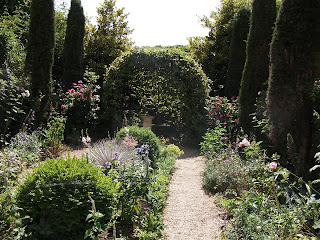Wednesday, 10 July 2013
The Herschel Museum of Astronomy
It's quite a small garden, behind an elegant terraced house in Bath, just out of the centre. It's not the sort of place you'd stumble across by chance, unless you were very lost! But this is the garden - this very spot - where William Herschel pointed his home made telescope at the night sky and discovered the planet Uranus. The discovery doubled the known size of our solar system at a single stroke.
What made it even more impressive was that he was self-taught. He was actually a musician, directing the music at the Octagon Chapel, composing and playing various instruments including the organ. As time went on, he spent more and more time on his astronomical research, including building telescopes - which included polishing the mirrors laboriously by hand, after casting the metal for them in his little workshop (the flagstones are seriously cracked due to an explosion with the molten metal!).
When he settled in Bath, he sent for his sister Caroline from Hanover to join him so she could run his household. He taught her English, and music (she was a fine singer, apparently) and mathematics, and she assisted him in his astronomical researches. She discovered eight comets herself, and was the first woman to be awarded a gold medal by the Royal Astronomical Society in 1828. She was also the first woman ever to earn a wage as a scientist.
One of her dresses is on display at the museum - she was tiny! Yet she lived to the age of 98, having moved back to Hanover on the death of her brother.
By this time, they had left Bath behind. King George III was so enthusiastic about William Herschel's work that he offered him £200 a year to move close to Windsor to devote himself to astronomical research where the King could visit him whenever he wanted. It was a significant drop in his income, but William didn't hesitate - he moved to Slough, and built a telescope so big it was marked on ordnance survey maps as one of the wonders of the age.
Down in the cellar of the house, they show a little film narrated by Patrick Moore, who was the Patron of the Museum. In the film, he describes William Herschel as probably the greatest astronomer of all time - and if Patrick Moore thought so, that's good enough for me. He built around 400 telescopes over the years, finally inventing a polishing machine for the mirrors after 15 years of doing it by hand. He also discovered infra-red radiation, while working with prisms, and coined the word "asteroid", among his other accomplishments. He also had wonderfully clear handwriting - several of his letters are on display and they are perfectly legible (I often have trouble deciphering old handwriting).
And here they are together - William looking up at the sky, and Caroline writing it all down - in a shady corner of the garden.
Subscribe to:
Post Comments (Atom)


No comments:
Post a Comment